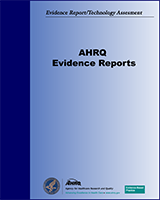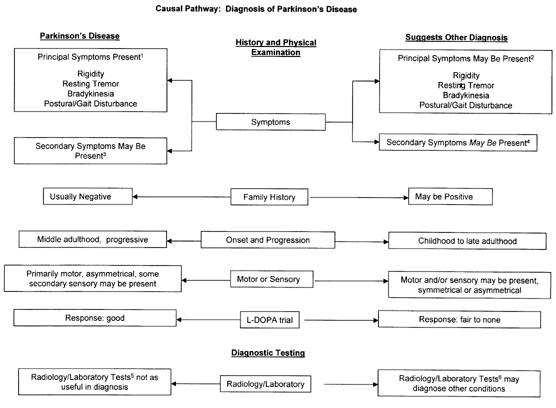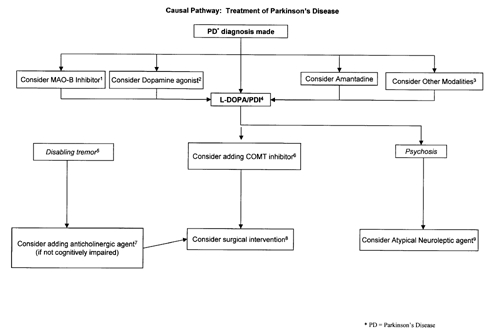NCBI Bookshelf. A service of the National Library of Medicine, National Institutes of Health.
Levine CB, Fahrbach KR, Siderowf AD, et al. Diagnosis and Treatment of Parkinson's Disease: A Systematic Review of the Literature. Rockville (MD): Agency for Healthcare Research and Quality (US); 2003 Jun. (Evidence Reports/Technology Assessments, No. 57.)
This publication is provided for historical reference only and the information may be out of date.

Diagnosis and Treatment of Parkinson's Disease: A Systematic Review of the Literature.
Show detailsPlease Note:
The causal pathways are not clinical practice guidelines, nor are they algorithms for decisions in patient care. They have been constructed solely for use as guides during this systematic review of the literature.

Causal Pathway: Diagnosis of Parkinson's Disease Legends
1Principal Symptoms Present:
*Two or more present, one of which is resting tremor or bradykinesia
- Rigidity affecting one or more limbs, cogwheel in nature
- Resting, postural tremor most often asymmetrical, 3–7 Hz, hands preferentially affected
- Bradykinesia (akinesia, hypokinesia)
- Postural/Gait disturbance often appears late in disease
2Principal Symptoms May Be Present:
*One or more may be present
- Rigidity affecting one or more limbs, may or may not be cogwheel in nature
- Tremor may be asymmetrical, but frequently bilateral and higher frequency (5–12 Hz). Head, voice, tongue, palate, leg and/or trunk tremor may occur
- Bradykinesia
- Postural/Gait disturbance
3Secondary Symptoms May Be Present:
- Psychiatric symptoms (depression, anxiety, psyshosis)
- Autonomic dysfunction (sexual dysfunction, orthostatic hypotension)
- Gastrointestinal dysfunction (constipation, weight loss, dysphagia)
- Urologic dysfunction
- Speech and swallowing problems
- Falls
- Sleep disturbances
- Visual disturbances
- Cognitive dysfunction (dementia)
- Olfactory dysfunction
- Difficulty writing
4Secondary Symptoms May Be Present:
(as above)
5Radiology/Laboratory Tests not as useful in diagnosis:
Results of computed tomography (CT), magnetic resonance imaging (MRI), cerebrospinal fluid analysis, and electroencephalography (EEG) are usually normal and of little diagnostic asistance.
Positron-emission tomography (PET scan) using radio-labeled dopa may be helpful in confirming a diagnosis.
6Radiology/Laboratory Tests helpful in diagnosis of other conditions:
CT, MRI useful to eliminating other disease processes such as tumors, strokes, hydrocephalus, etc. Laboratory investigation should be performed when atypical symptoms exist, there is a strong family history or early age of onset.

Causal Pathway: Treatment of Parkinson's Disease Legends
For all medications, start with low dose, increase dose slowly until:
symptoms abate OR
maximum dose is reached OR
intolerable side effects occur.
Only make one medication change at a time.
1 MAO-B Inhibitors: Monoamine oxidase B inhibitors (for neuroprotection):
2 Seligiline, Rasagiline
3 Dopamine Agonists : Bromocriptine, Pergolide, Pramipexole, Andropinrole,
4 Cabergoline, Ropinirole, Apomorphine (activate dopamine receptors)
5 Other Modalities: Rehabilitation, Physical Therapy, Occupational Therapy, Speech Therapy, Counseling, Dietary Changes.
6 L-DOPA/PDI: Levodopa/Carbidopa (peripheral decarboxylase inhibitor)
7 Disabling tremor: may occur any time during the course of the disease.
8 COMT inhibitors: Catechol-O-methylransferase inhibitor: Tolcapone, Entacapone
9 Anticholinergic agents: Trihexylphenidyl, Benztropine, Procyclidine
10 Surgical interventions: pallidotomy, thalamotomy, deep brain stimulation, fetal nigral implants.
11 Atypical Neuroleptic agents: Clozapine, Olanzapine, Quietipine
Many aspects of this causal pathway are controversial, including when to initiate therapy with L-DOPA, and when to use other agents. Monitoring for toxicities should be done throughout treatment, and is not specifically mentioned in this pathway. Similarly, physical therapy, counseling, speech therapy, and rehabilitation should start as soon as PD is diagnosed, and continue indefinitely.
The causal pathways are not clinical practice guidelines, nor are they algorithms for decisions in patient care. They have been constructed solely for use as guides during this systematic review of the literature.
- Appendix D. Causal Pathways: Diagnosis and Treatment of Parkinson's Disease - Di...Appendix D. Causal Pathways: Diagnosis and Treatment of Parkinson's Disease - Diagnosis and Treatment of Parkinson's Disease
- References - Defining and Managing Chronic Fatigue SyndromeReferences - Defining and Managing Chronic Fatigue Syndrome
- Introduction - Defining and Managing Chronic Fatigue SyndromeIntroduction - Defining and Managing Chronic Fatigue Syndrome
Your browsing activity is empty.
Activity recording is turned off.
See more...